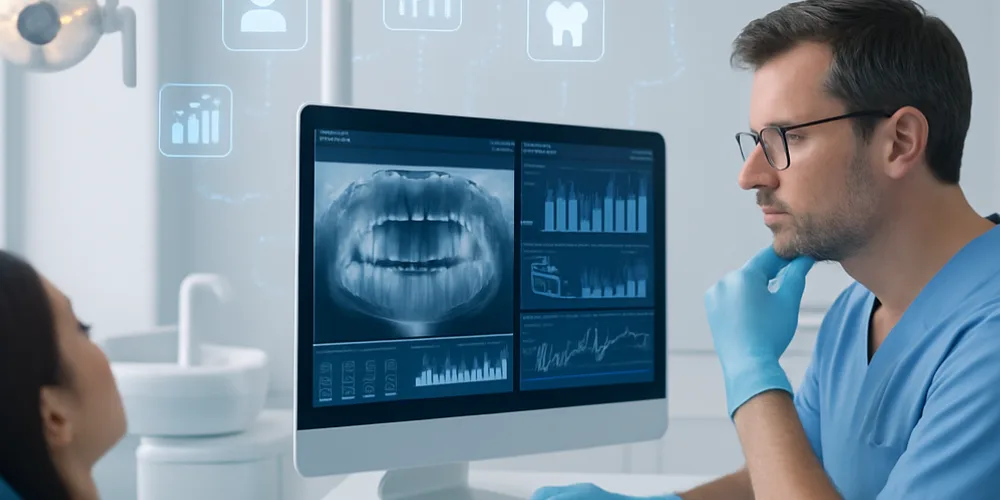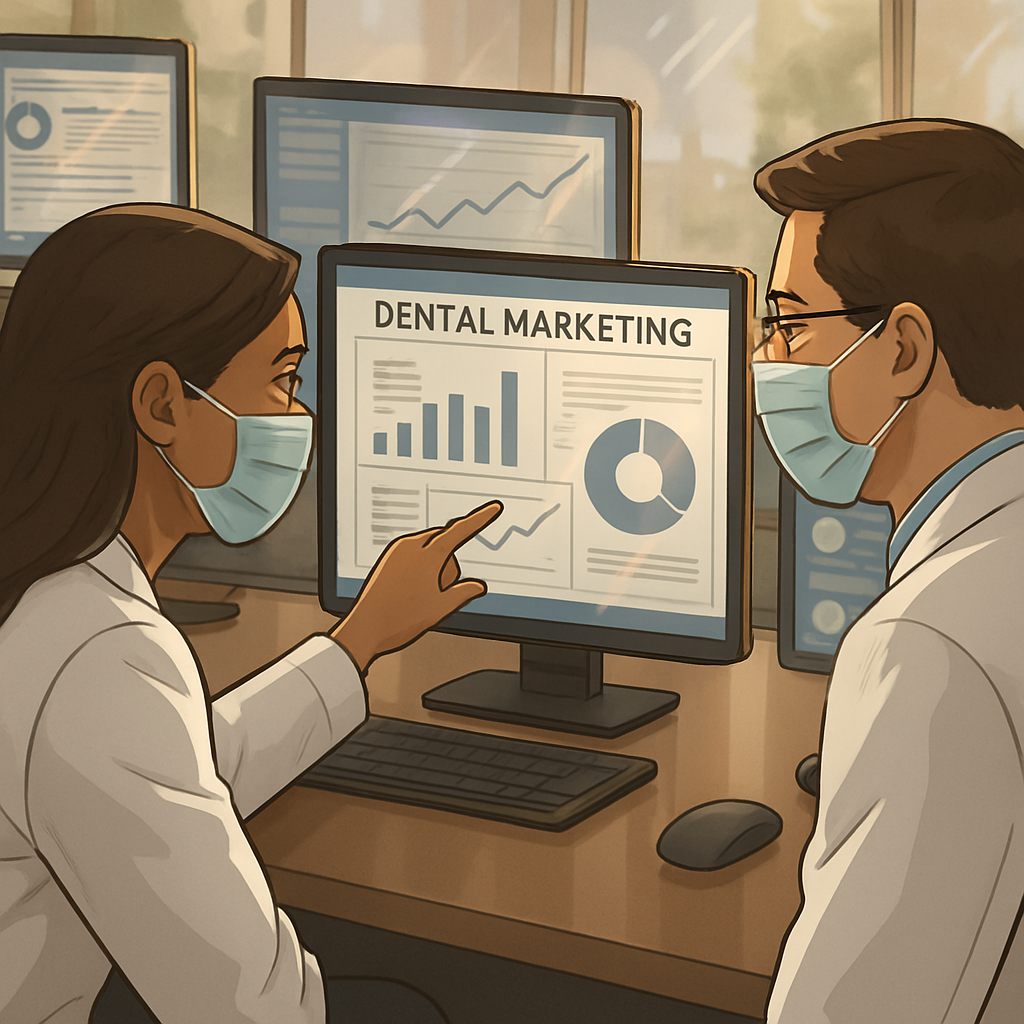November 14, 2025
7 min
Guide for multi-location dental groups to measure real ROI using defined KPIs, accurate data mapping, attribution models, cost allocation, and step-by-step methods to validate decisions.
September 3, 2025
9 minutes
Smart dental marketing automation transforms clicks into patients by streamlining reminders, lead nurturing, and engagement.

If you spend any time thinking about how a dental practice can stay ahead, you eventually run into two concepts: technology and leverage. Everyone talks about digital marketing, but most folks haven't internalized what that actually means. The people who do take it seriously tend to reach for automation. Marketing automation, in particular, is like a lever dentists can pull to get from "someone clicked our ad" to "someone's sitting in the chair." Rather than relying on chance, you have a way to bridge the chasm between fleeting online intrigue and consistent, real-life patient flow. Automation isn't just a tool for reducing drudge work; it's about creating seamless, tailored interactions at scale—turning randomness into systems, and systems into results.
Think of all the repeatable, boring work in your practice: reminding people of appointments, sending the same old follow-up emails, and tracking leads through the pipeline. Dental marketing automation chains all this tedium to software. You’re not just buying convenience; you’re buying attention—attention you can refocus from clerical chores to real patient care. When every message is both consistent and crafted with each patient in mind, your practice starts operating at a level most competitors can't match.
Smart practices enhance this with customizable marketing workflows, ensuring communication feels natural while staying efficient across every channel.
1) Identify Goals and Objectives
Start with the destination. What are you trying to achieve? More bookings? Higher retention? Pick numbers that matter—say, a 20% bump in new visits over half a year. Make these outcomes explicit, or else your automation will wander into the weeds.
2) Select the Right Marketing Automation Tools
Not all software is created equal. Consider looking beyond feature checklists and ask, "Does this truly align with my workflow? Does staff hate it after a week?" Demos and user testimonials unmask the sales gloss. Look for tight EHR integration, intuitive dashboards, and a real support channel. NexHealth, Hi5 Practice, ConvertLens—they all optimize differently. The best choice is the one that bends to your way of working, not vice versa.
3) Set Up Automation Workflows
Lay out the dominoes. What triggers what? Booking an appointment spins off reminders; leaving the office generates a feedback survey. Map as many patient journeys as you can—then use the software to automate every repeatable step, so nothing falls through.
4) Integrate with Existing Systems
If your new tools don't talk to your EHR, you're sunk. Seek APIs and pre-built integrations, especially with platforms like Dentrix or Open Dental. Anything that creates friction will erode the efficiency you’re trying to gain.
5) Monitor and Optimize Efforts
Don’t just set and forget. Every metric—from open rates to show-ups—gives you a signal. Check your dashboards often, tweak your workflows, and create feedback loops where the software gets smarter with each cycle. Sustained improvement is a function of vigilance, not luck.
6) Training and Support
If your team doesn’t get it, your patients won’t either. Onboard staff thoroughly, revisit training as updates roll out, and ensure there's always someone who knows how to solve the weird cases. Ongoing support is the difference between adoption and abandonment.
Case Study 1: Dental Associates of Walpole
Here’s a story: Dental Associates of Walpole was fed up watching patients and staff struggle with insurance headaches. They wanted a system that minimized friction—so they rolled out DentalHQ for automated membership management. With automation taking over the grunt work (payments, engagement, reminders), they posted a 3% revenue gain in seven months and lifted both retention and satisfaction. Out of roughly 2,000 uninsured patients, they pulled 134 into the new program fast. That's not some rounding-error growth—it's a material shift in practice economics, made possible by automation running in the background. Tracking this performance is easier with marketing ROI analytics, ensuring practices understand the true return of their investments.
Case Study 2: Full-Arch Funnel Strategy
Another set of practices took a page from the SaaS playbook, building a full marketing funnel for big-ticket cases. Instead of hoping patients stumbled onto the practice, they mapped every step: awareness, education, booking. Automation delivered targeted texts, emails, and reminders at each phase—improving conversions and making the whole pipeline visible. The promise isn’t just more appointments; it’s a systematic way to understand and meet patient needs, wherever they’re entering the funnel.
"The integration of AI and machine learning is transforming dental marketing by not only automating processes but also by providing predictive insights that drive patient engagement." – Industry Expert, Healthcare Marketing
Talk of AI and machine learning in dental marketing isn’t pie-in-the-sky. It’s operational reality. When practices plug in AI-driven engagement tools, they begin to anticipate instead of just respond—predicting needs, personalizing outreach, and opening up new channels of patient interaction. One hospital’s experiment with personalized mobile interactions slashed 30-day revisit rates—proof that automation, given the right data, can drive real outcomes across the health sector.
Impact of Mobile-First Strategies
Mobile isn’t a trend; it’s the ground state. Any marketing campaign that isn’t optimized for smartphones is leaving patients—and money—on the table. Patients book and message on their phones because it’s fast and easy. Your job is to lower barriers, not add steps. The result isn’t just convenience—it's higher satisfaction all around.
Embracing Augmented Reality (AR)
AR is starting to crack the mainstream. It’s not just a demo; it’s a tool to lower patient anxiety and increase understanding. Patients visualize procedures before they commit, defusing uncertainty and building trust. The upshot: more informed decisions and a practice that feels modern and transparent.
Future Predictions for Dental Marketing
The next wave arrives data-first. AI and analytics will only get more central, with automation driving not just acquisition but lifelong engagement. Relationship-driven practices will win, as the tools shift from raw lead-chasing to curated, ongoing patient journeys. Adapt to these changes, and your practice isn’t just reacting to market trends—it’s setting them.

Most dental offices are drowning in micro-tasks. Marketing automation doesn’t solve all your problems, but it gives your staff back time, cuts cognitive load, and (done right) increases conversion rates. The crucial bit is finding a tool that fits your quirks: matching your current stack, budget, and technical comfort.
1) NexHealth: One-click booking, EHR integration. Highly recommended for innovative practices.
2) ConvertLens: AI-driven solutions, Interactive Dashboard, Intelligent Lead CRM, Marketing ROI Analytics. Praised for seamless PMS integration and customizable workflows
3) PracticeMojo: Comprehensive patient communication, Automated appointment reminders, Loyalty campaigns. Well-suited for reducing no-shows and enhancing patient engagement
Feature sets are just the start—real utility comes from integration, workflow impact, and the stories of actual users. Take the time to trial software, seek feedback from peers, and watch for red flags in usability and support before making a final pick.
1) Over-automation Concerns
Not everything should be automated. Strip away non-essential touchpoints, but don’t replace conversations that build trust. First visits, sensitive follow-up—these require the nuance that only real humans can provide. If you try to automate friendship, it just creeps people out.
2) Ensuring Patient Data Security
With more data comes more responsibility. Only work with tools that are HIPAA-compliant, and make regular security audits routine. The cost of a breach isn’t just fines; it’s the loss of trust you’ll never fully recover. Train staff, test defenses, and stay ahead of the regulatory curve.
3) Balancing Automation with Personalization
The best automation feels invisible and personal. Use segmentation to craft tailored messages, but don’t let software replace your intuition about when to reach out as a human. Smart CRMs can get you 80% there, but one well-timed manual call or note still beats a thousand automated nudges.
4) Inadequate Training on Automation Tools
Don’t assume software will just "work." Roll out a training plan, not just a sales demo. Staff need to know not only how to use the tools but also when—especially in messy, high-touch scenarios. A tool unused is a waste, and a tool misused can do real harm.
5) Lack of Regular Monitoring and Optimization
Set-and-forget is a myth. Review key metrics weekly, test tweaks, and double down on what works. The practices that thrive are the ones closing the loop, learning from data, and iterating—constantly.
Smart dental marketing automation isn’t another shiny object. It’s a shift in how practices think about their business: less luck, more inevitability. With the right strategy, tools, and vigilance, there’s no reason clicks can’t turn into real, sustained patient growth. The next step? Don’t just read about it—start experimenting. Reach out to providers like ConvertLens, trial the best tools, and start measuring the progress. Real results start with first steps.
1. What is dental marketing automation?
Dental marketing automation refers to the use of software and technology to streamline marketing tasks and processes in dental practices. This includes scheduling social media posts, managing email campaigns, and tracking patient engagement automatically.
2. How can dental marketing automation benefit my practice?
By automating marketing tasks, dental practices can save time, increase efficiency, and ensure consistent communication with patients. It helps in improving patient engagement, increasing appointment bookings, and ultimately driving revenue growth.
3. What features should I look for in a dental marketing automation tool?
Key features to consider include email marketing capabilities, social media management, patient relationship management, analytics and reporting tools, and integration with practice management software to enhance overall functionality.
4. Is dental marketing automation suitable for small practices?
Yes, dental marketing automation is suitable for practices of all sizes, including small practices. It helps smaller practices compete effectively by providing tools to manage marketing efforts efficiently without requiring extensive time or resources.



Sign Up Now & Someone from Our Team Will Be in Touch Shortly!
Use the form below to send us a message, and we’ll get back to you as soon as we can.